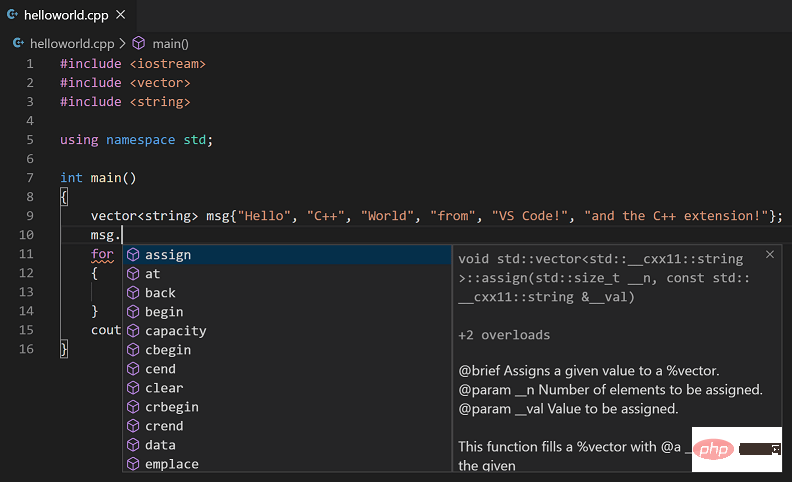
C++中常见的垃圾回收问题解决方案,需要具体代码示例
引言:
C++是一种强大的编程语言,提供了灵活和高效的内存管理机制。然而,手动管理内存可能导致内存泄漏和悬挂指针等问题。为了解决这些问题,开发人员通常会使用垃圾回收机制。本文将介绍C++中常见的垃圾回收问题,并给出解决方案和具体的代码示例。
一、垃圾回收问题及解决方案:
- 内存泄漏:
内存泄漏是指程序在完成某个操作后,没有正确释放已分配的内存,导致这部分内存无法再被访问或释放,从而造成内存占用过度的问题。为了解决内存泄漏问题,可以使用智能指针。
智能指针是一种自动管理内存的指针类,它会在对象不再被使用时自动释放对象所占用的内存。C++11引入了std::shared_ptr和std::unique_ptr两种类型的智能指针。std::shared_ptr和std::unique_ptr两种类型的智能指针。
下面是一个使用std::shared_ptr的示例:
#include <memory>
class MyClass {
public:
MyClass() {
std::cout << "MyClass constructor" << std::endl;
}
~MyClass() {
std::cout << "MyClass destructor" << std::endl;
}
};
int main() {
std::shared_ptr<MyClass> ptr(new MyClass);
return 0;
}在上面的示例中,当main()函数执行完毕时,std::shared_ptr会自动释放MyClass对象所占用的内存。
- 悬挂指针:
悬挂指针是指一个指针仍然指向已被释放的内存。当程序试图访问这个指针所指向的内存时,会引发未定义行为。为了避免悬挂指针问题,可以使用智能指针。
下面是一个使用std::unique_ptr的示例:
#include <memory>
class MyClass {
public:
MyClass() {
std::cout << "MyClass constructor" << std::endl;
}
~MyClass() {
std::cout << "MyClass destructor" << std::endl;
}
};
int main() {
std::unique_ptr<MyClass> ptr(new MyClass);
return 0;
}在上面的示例中,当main()函数执行完毕时,std::unique_ptr会自动释放MyClass对象所占用的内存,避免了悬挂指针问题。
- 内存碎片:
内存碎片是指内存空间被分割成多个小块,而应用程序无法分配大块连续内存的问题。在长时间运行的程序中,内存碎片可能导致内存分配失败。为了解决内存碎片问题,可以使用内存池。
下面是一个使用内存池的示例:
#include <iostream>
#include <vector>
class MemoryPool {
public:
MemoryPool(size_t size) {
for (int i = 0; i < size; ++i) {
memory_.push_back(new char[1024]);
}
}
~MemoryPool() {
for (auto it = memory_.begin(); it != memory_.end(); ++it) {
delete[] (*it);
}
}
void* allocate() {
if (!memory_.empty()) {
void* ptr = memory_.back();
memory_.pop_back();
return ptr;
}
return nullptr;
}
void deallocate(void* ptr) {
memory_.push_back(ptr);
}
private:
std::vector<void*> memory_;
};
int main() {
MemoryPool pool(10);
// 使用内存池分配内存
void* ptr1 = pool.allocate();
void* ptr2 = pool.allocate();
// 使用内存池释放内存
pool.deallocate(ptr1);
pool.deallocate(ptr2);
return 0;
}在上面的示例中,MemoryPool类使用一个std::vector来管理内存池,通过allocate()函数分配内存,通过deallocate()
std::shared_ptr的示例:rrreee
在上面的示例中,当main()函数执行完毕时,std::shared_ptr会自动释放MyClass对象所占用的内存。
- 悬挂指针:🎜🎜🎜悬挂指针是指一个指针仍然指向已被释放的内存。当程序试图访问这个指针所指向的内存时,会引发未定义行为。为了避免悬挂指针问题,可以使用智能指针。🎜🎜下面是一个使用
std::unique_ptr的示例:🎜rrreee🎜在上面的示例中,当main()函数执行完毕时,std::unique_ptr会自动释放MyClass对象所占用的内存,避免了悬挂指针问题。🎜- 🎜内存碎片:🎜🎜🎜内存碎片是指内存空间被分割成多个小块,而应用程序无法分配大块连续内存的问题。在长时间运行的程序中,内存碎片可能导致内存分配失败。为了解决内存碎片问题,可以使用内存池。🎜🎜下面是一个使用内存池的示例:🎜rrreee🎜在上面的示例中,
MemoryPool类使用一个std::vector来管理内存池,通过allocate()函数分配内存,通过deallocate()函数释放内存,避免了内存碎片问题。🎜🎜结论:🎜🎜本文介绍了C++中常见的垃圾回收问题及其解决方案,并给出了具体的代码示例。通过合理使用智能指针和内存池,可以避免内存泄漏、悬挂指针和内存碎片等问题,提高程序的稳定性和效率。希望这些解决方案能够对C++开发人员在垃圾回收方面的工作有所助益。🎜以上是C++中常见的垃圾回收问题解决方案的详细内容。更多信息请关注PHP中文网其他相关文章!
 Windows 11 系统下的五款最佳免费 C++ 编译器推荐Apr 23, 2023 am 08:52 AM
Windows 11 系统下的五款最佳免费 C++ 编译器推荐Apr 23, 2023 am 08:52 AMC++是一种广泛使用的面向对象的计算机编程语言,它支持您与之交互的大多数应用程序和网站。你需要编译器和集成开发环境来开发C++应用程序,既然你在这里,我猜你正在寻找一个。我们将在本文中介绍一些适用于Windows11的C++编译器的主要推荐。许多审查的编译器将主要用于C++,但也有许多通用编译器您可能想尝试。MinGW可以在Windows11上运行吗?在本文中,我们没有将MinGW作为独立编译器进行讨论,但如果讨论了某些IDE中的功能,并且是DevC++编译器的首选
 C++报错:变量未初始化,应该如何解决?Aug 21, 2023 pm 10:01 PM
C++报错:变量未初始化,应该如何解决?Aug 21, 2023 pm 10:01 PM在C++程序开发中,当我们声明了一个变量但是没有对其进行初始化,就会出现“变量未初始化”的报错。这种报错经常会让人感到很困惑和无从下手,因为这种错误并不像其他常见的语法错误那样具体,也不会给出特定的代码行数或者错误类型。因此,下面我们将详细介绍变量未初始化的问题,以及如何解决这个报错。一、什么是变量未初始化错误?变量未初始化是指在程序中声明了一个变量但是没有
 C++编译错误:未定义的引用,该怎么解决?Aug 21, 2023 pm 08:52 PM
C++编译错误:未定义的引用,该怎么解决?Aug 21, 2023 pm 08:52 PMC++是一门广受欢迎的编程语言,但是在使用过程中,经常会出现“未定义的引用”这个编译错误,给程序的开发带来了诸多麻烦。本篇文章将从出错原因和解决方法两个方面,探讨“未定义的引用”错误的解决方法。一、出错原因C++编译器在编译一个源文件时,会将它分为两个阶段:编译阶段和链接阶段。编译阶段将源文件中的源码转换为汇编代码,而链接阶段将不同的源文件合并为一个可执行文
 如何优化C++开发中的文件读写性能Aug 21, 2023 pm 10:13 PM
如何优化C++开发中的文件读写性能Aug 21, 2023 pm 10:13 PM如何优化C++开发中的文件读写性能在C++开发过程中,文件的读写操作是常见的任务之一。然而,由于文件读写是磁盘IO操作,相对于内存IO操作来说会更为耗时。为了提高程序的性能,我们需要优化文件读写操作。本文将介绍一些常见的优化技巧和建议,帮助开发者在C++文件读写过程中提高性能。使用合适的文件读写方式在C++中,文件读写可以通过多种方式实现,如C风格的文件IO
 C++编译错误:无法为类模板找到实例化,应该怎么解决?Aug 21, 2023 pm 08:33 PM
C++编译错误:无法为类模板找到实例化,应该怎么解决?Aug 21, 2023 pm 08:33 PMC++是一门强大的编程语言,它支持使用类模板来实现代码的复用,提高开发效率。但是在使用类模板时,可能会遭遇编译错误,其中一个比较常见的错误是“无法为类模板找到实例化”(error:cannotfindinstantiationofclasstemplate)。本文将介绍这个问题的原因以及如何解决。问题描述在使用类模板时,有时会遇到以下错误信息:e
 iostream头文件的作用是什么Mar 25, 2021 pm 03:45 PM
iostream头文件的作用是什么Mar 25, 2021 pm 03:45 PMiostream头文件包含了操作输入输出流的方法,比如读取一个文件,以流的方式读取;其作用是:让初学者有一个方便的命令行输入输出试验环境。iostream的设计初衷是提供一个可扩展的类型安全的IO机制。
 C++中的信号处理技巧Aug 21, 2023 pm 10:01 PM
C++中的信号处理技巧Aug 21, 2023 pm 10:01 PMC++是一种流行的编程语言,它强大而灵活,适用于各种应用程序开发。在使用C++开发应用程序时,经常需要处理各种信号。本文将介绍C++中的信号处理技巧,以帮助开发人员更好地掌握这一方面。一、信号处理的基本概念信号是一种软件中断,用于通知应用程序内部或外部事件。当特定事件发生时,操作系统会向应用程序发送信号,应用程序可以选择忽略或响应此信号。在C++中,信号可以
 c++数组怎么初始化Oct 15, 2021 pm 02:09 PM
c++数组怎么初始化Oct 15, 2021 pm 02:09 PMc++初始化数组的方法:1、先定义数组再给数组赋值,语法“数据类型 数组名[length];数组名[下标]=值;”;2、定义数组时初始化数组,语法“数据类型 数组名[length]=[值列表]”。


热AI工具

Undresser.AI Undress
人工智能驱动的应用程序,用于创建逼真的裸体照片

AI Clothes Remover
用于从照片中去除衣服的在线人工智能工具。

Undress AI Tool
免费脱衣服图片

Clothoff.io
AI脱衣机

AI Hentai Generator
免费生成ai无尽的。

热门文章

热工具

螳螂BT
Mantis是一个易于部署的基于Web的缺陷跟踪工具,用于帮助产品缺陷跟踪。它需要PHP、MySQL和一个Web服务器。请查看我们的演示和托管服务。

VSCode Windows 64位 下载
微软推出的免费、功能强大的一款IDE编辑器

Dreamweaver Mac版
视觉化网页开发工具

SublimeText3 英文版
推荐:为Win版本,支持代码提示!

记事本++7.3.1
好用且免费的代码编辑器





